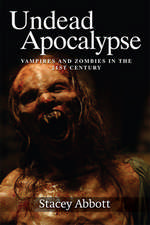Death and the Moving Image
Autor Michele Aaronen Limba Engleză Paperback – 30 mar 2015
| Toate formatele și edițiile | Preț | Express |
|---|---|---|
| Paperback (1) | 162.20 lei 3-5 săpt. | |
| EDINBURGH UNIVERSITY PRESS – 30 mar 2015 | 162.20 lei 3-5 săpt. | |
| Hardback (1) | 554.62 lei 3-5 săpt. | |
| EDINBURGH UNIVERSITY PRESS – 30 ian 2014 | 554.62 lei 3-5 săpt. |
Preț: 162.20 lei
Preț vechi: 180.64 lei
-10% Nou
Puncte Express: 243
Preț estimativ în valută:
31.04€ • 32.47$ • 25.78£
31.04€ • 32.47$ • 25.78£
Carte disponibilă
Livrare economică 12-26 martie
Preluare comenzi: 021 569.72.76
Specificații
ISBN-13: 9781474402750
ISBN-10: 1474402755
Pagini: 272
Ilustrații: 10 b&w illustrations
Dimensiuni: 155 x 234 x 23 mm
Greutate: 0.48 kg
Editura: EDINBURGH UNIVERSITY PRESS
ISBN-10: 1474402755
Pagini: 272
Ilustrații: 10 b&w illustrations
Dimensiuni: 155 x 234 x 23 mm
Greutate: 0.48 kg
Editura: EDINBURGH UNIVERSITY PRESS
Notă biografică
Cuprins
Introduction: Death and the 'Moving' Image; PART I: BEFORE - FLIRTING WITH DEATH; 1. Narrative Suicide and the Subject of Film; 2. S&M and (or as) Cinema: Sexual Risk and Visible Pleasures; 3. Un/Safe Texts: Apocalypse, Millennial Cinema and the Traumatised Spectator; PART II: DURING - ACTUALISING DEATH; 4. The Language of Pain: Illness, Injury and the Aesthetics of Dying; 5. Who Buys It? Dying and Difference; 6. Murder and Self-Reflexivity: the Implicated Spectator; PART III: AFTER - DEALING WITH DEATH; 7. Medium, Memory and Mortality; 8. Good Grief: Ghosts, Spectres and the Denial of Death; 9. The Unconscious and the Unconscionable: Filming Death and the Complicitous Spectator; Conclusion: The Trauma of Cinema, or the Still 'Moving' Image.











